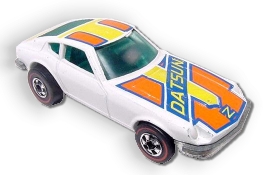While many people, especially Americans think of the 1970’s when you mention Datsun cars, the company actually began in 1912. A Japanese engineer, Masujiro Hashimoto who was trained in the United States started a car company called “Kwaishinsha Motor Works” in Tokyo and built a prototype for a small car.
After about two years of shopping the car around to various financiers, Mr. Hashimoto secured the backing of three men; Mr. K. Den, Mr. R. Aoyama and Mr. A. Takeuchi. Taking the initials of the three men’s last names, (“D”, “A” and “T”), the car was named “DAT”. The name honored the financial backers, and also translated to the Japanese word for “hare”. Early models such as the 1935 Datsun 14 Sedan featured a rabbit hood ornament “symbolizing the car’s blazing speed”, (it had a top speed of approx. 50mph).
The DAT31 was produced in 1915 with a 4 cylinder 2.0 litre engine, and the following year the DAT41 was produced with a more powerful 2.3 litre 4-cylinder. The cars were produced through 1926 at which time the company began producing trucks. In 1925 the company had changed it’s name to DAT Motor Company and moved from Tokyo to Osaka where it merged with the Jitsuyo Jidosha Co.
The merged company also continued to produced Jitsuyo’s Lila Light Car, which had a narrow wheel base and was popular with Japanese Taxi drivers as it could fit into tight places.
By 1931, “DAT” was bought out by a larger company called Tabata Imono as part of that company’s plan to build a mass produced Japanese car to compete with American exports. Using the prototype of the 1931 DAT, the car went into production in 1932 and was renamed “Datson” — literally meaning “son of DAT”.
For two reasons, the name was quickly changed from Datson to Datsun. The first was that the word “son” in Japanese means “loss”, (or “fail”), and the second was so that the rising sun, a national symbol in Japan could be incorporated into the name of the car.
In 1932, approximately 150 Datsun’s were manufactured in roadster, touring and salon models. Production continued but on June 1, 1934 the name of the company was changed to Nissan Motor Co. Ltd., and the factory was moved from Osaka to Yokahama. By mid-1934 the 1000th Datsun was produced.
The early Datsun featured a 495cc four-cylinder engine, semi-eliptical rear suspension, worm gear drive, and were capable of a top speed of approximately 35mph. In 1935 engine size was increased to 725cc. In the early 1970’s Datsun produced the 240Z, (followed by the 260Z, then the 280Z and ZX models), and entered the performance sports car market.
In 1966, Nissan ran a promotion inviting the public to name it’s new car, (the B210 model), with nearly 8.5 million post card responses the company took the public’s suggestion and the car was named the “Sunny” (in the Japanese market — in the US it was sold as the Datsun B210).
Eventually, the Datsun name was dropped and the cars were simply marketed under the Nissan brand.
While many models are produced for both Japanese and for export markets, the Japanese seem to prefer light-hearted names for their cars as is the case with the Nissan Model S30 which was marketed in Japan as the Fairlady but sold in the US as the 240Z.
In late 1989, Nissan followed the export success of it’s Datsun and Nissan models by introducing a high end line of cars and SUV’s to the North American market under the Infiniti brand name.
In 1990, the Nissan 300ZX Turbo won the coveted Motor Trend’s Import Car of the Year award. The legend of the “Z Car” which has it’s roots in the little “DAT” car engineered by Mr. Hashimoto in 1912 continues today, nearly 100 years later in the Nissan Z and Infinity G series models.
Bibliography & Web Resources:
• Encyclopedia of the Car, 1998, Chartwell Books Inc.
• Motor Trend Magazine – www.motortrend.com
• Nissan Motor Co. Ltd. – www.nissan-global.com
• Infiniti at en.wikipedia.org
• Datsun at en.wikipedia.org

